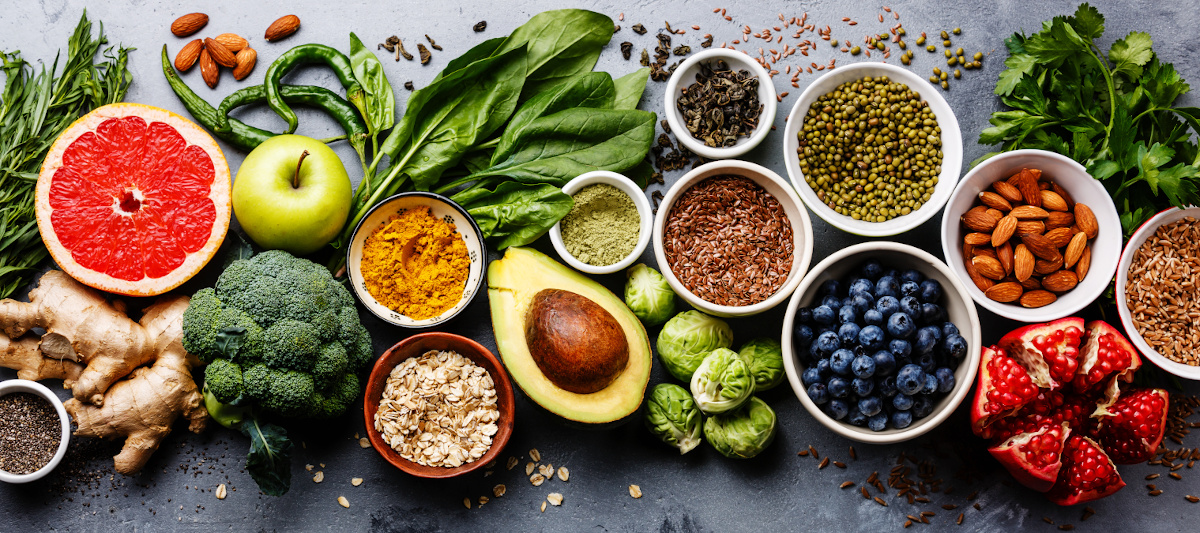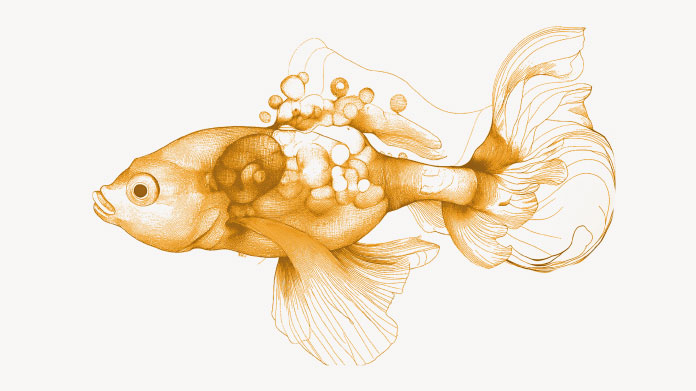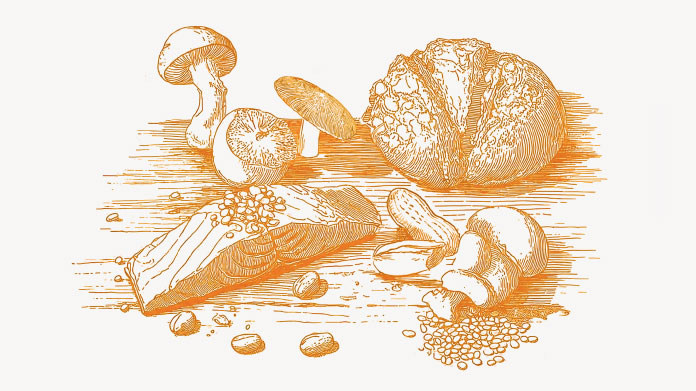An antioxidant for everyone. Which one is best for you?
Metals rust, fruit and vegetables wilt, fats go rancid … the human body is by no means the only victim of oxidation, the process that leads to irreversible cell damage and which is associated with around 100 diseases - cancer and cardiovascular problems topping the list. In humans, it has a major but largely unknown origin: the vital conversion of oxygen into water.

Fortunately, the body is prepared for such attacks - at least in theory. It uses two complementary antioxidant defence systems: one internal, consisting of enzymes (such as glutathione peroxidase), tiny molecules (such as carotenoids, vitamins C and E, uric acid, bilirubin, and ubiquinone) and proteins (ferritin, transferrin), and the other external, which relies on dietary intake of antioxidants produced by other organisms, particularly vegetables. In both cases, the objective is to ensure the right balance between the amount of reactive species generated, and the level of antioxidants necessary to neutralise them.
- However, this balance can be upset when:
- Reactive Oxygen Species are generated so rapidly that they overwhelm both defence systems.
- External antioxidant intake is inadequate and the body’s internal system can no longer compensate.
The only way to intervene effectively is with antioxidants, and while all dietary antioxidants can stem the process, some are more effective than others, depending on the particular situation.
The antioxidant for those with ‘screen eyes’
The conversion of oxygen into water is not the only factor responsible for generating reactive oxygen species. Smoke, wind, sun and also light place the body under continual attack, particularly the eyes, which are in constant contact with the environment. Those who work in front of a screen all day, or who frequently look at their tablets, smartphones and TVs, are regularly exposing themselves to blue light, a light spectrum recognised for its harmful effects on the retina and cornea2 (one of the rare body tissues not to contain blood vessels). Over time, the reactive oxygen species generated by the effects of radiation damage the cells in the eye and promote the development of three ocular diseases: AMD, cataracts and presbyopia3.
To counteract oxidation of eye cells and absorb some of the light rays that damage the retina, by far the best solution is ingestion of carotenoids, particularly lutein, which together with zeaxanthin and meso-zeaxanthin make up the yellow pigment of the macula. The thicker this macular pigment, the lower the risk of AMD or cataract4,5,6.
Lutein-rich foods: green cabbage (24 mg), spinach (20 mg), squash (3-4 mg), broccoli (2 mg), peas (2 mg).
The perfect lutein supplement : Lutein 20 mg
The antioxidant for sun-seekers
The sun’s rays, particularly ultraviolet radiation, contributes significantly to levels of oxidative stress in those with regular exposure to the sun. Plants, which rely almost exclusively on this source of energy, have adapted to protect themselves from its harmful effects by producing and using carotenoid antioxidants. And this works on our skin too7! Eating foods rich in carotenoids, particularlylycopene, translates directly into an increase in the skin’s lycopene content, improving absorption of UV rays and reducing deterioration of cells8. And it’s a worthwhile reduction, as over the long term, cell deterioration causes premature ageing of the skin and promotes the development of skin cancer – 50-70% of skin cancer cases are directly associated with over-exposure to UV rays.Even though consumption of lycopene (the best food sources of which are the summer fruits tomatoes and melons) can reduce the erythema caused by overexposure to the sun, it should never be seen as a replacement for topical sun protection. Its role is primarily to boost the skin’s antioxidant defences in people who spend a lot of time outside9. That is why it is important to ensure a regular intake of lycopene, which can be facilitated by taking a supplement.
Lycopene-rich foods: guava (5 mg), watermelon (4.5 mg), tomatoes (3 mg), papaya (1.8 mg), grapefruit (1.7 mg).
The perfect lycopene supplement : Lyc-O-Mato® (14 mg)
The antioxidant for sports enthusiasts
Physical exercise, when taken regularly and relatively intensively, also causes oxidative stress. The body is able to adjust its antioxidant production to compensate, but over time, requires an increase in external supply of antioxidants to avoid being overwhelmed. One of the antioxidants it most needs is vitamin C. The recommended daily amount of vitamin C for a normal adult is 110mg/day but sports enthusiasts are advised to increase this significantly10,11. This particular antioxidant helps restore glycogen reserves, contributes to muscle tissue synthesis and improves absorption of iron, requirements for which also increase with physical activity.Studies have shown that adequate supplementation by sportspeople improves their antioxidant defences and immune systems12 and may also improve performance13. It is, however, important for supplementation to remain reasonable – excessive levels may produce exactly the opposite of the desired effect (pro-oxidant).
Vitamin C-rich foods : red pepper (100-160 mg), papaya (90 mg), kiwi (70 mg), orange (70 mg), mango (55 mg).
The perfect vitamin C supplement : Liposomal Vitamin C (335 mg)
The solution for those with a poor diet
Dozens of studies show that those with low blood levels of antioxidants are at greater risk of developing cardiovascular disease14and on this basis, nutrition experts across the globe recommend eating more fruit and vegetables. Unfortunately, however, this does not seem to be working: a study conducted a few years ago showed that only 4% of Western populations were actually consuming the minimum five portions of fruit and vegetables recommended by health authorities15.For those who are not eating a balanced diet, it may be better to concentrate on consuming a wide range of antioxidants at nutritional doses rather than one specific antioxidant at a high dose. Researchers at University of California’s School of Public Health have also identified other groups of people for whom such advice is equally relevant16:
- the over-60s
- women of child-bearing age
- women who are pregnant or breastfeeding
- vegans
- heavy smokers or drinkers
- those on a weight-loss diet.
References
2. Dawson, et al, Local fundus response to blue (LED and laser) and infrared (LED and laser) sources, Exp.Eye Res., 73(1):137-47 2001.
3. Avis de l’Anses, Effets sanitaires des systèmes d’éclairage utilisant des diodes électroluminescentes (LED), Octobre 2010,
4. Hankinson SE, Stampfer MJ, et al. Nutrient intake and cataract extraction in women: a prospective study.BMJ. 1992 Aug 8;305(6849):335-9.
5. Associations between age-related nuclear cataract and lutein and zeaxanthin in the diet and serum in the Carotenoids in the Age-Related Eye Disease Study, an Ancillary Study of the Women's Health Initiative. Moeller SM, Voland R, et al, CAREDS Study Group; Women's Health Initiative. Arch Ophthalmol. 2008 Mar;126(3):354-64. Texte integral : archopht.ama-assn.org
6. A randomised controlled trial investigating the effect of lutein and antioxidant dietary supplementation on visual function in healthy eyes. Bartlett HE, Eperjesi F. Clin Nutr. 2008 Apr;27(2):218-27.
7. Wilhelm Stahl, Helmut Sies. Photoprotection by dietary carotenoids: Concept, mechanisms, evidence and future development, Mol. Nutr. Food Res. 2011, 2 28 29 56, –7 5 DOI 10.1002/mnfr.201100232
8. Scarmo, S., Cartmel, B., Lin, H., Leffell, D. J. et al., Significant correlations of dermal total carotenoids and dermal lycopene with their respective plasma levels in healthy adults. Arch. Biochem. Biophys. 2010, 504, 34–39
9. Aust, O., Stahl, W., Sies, H., Tronnier, H., Heinrich, U., Supplementation with tomato-based products increases lycopene, phytofluene, and phytoene levels in human serum and protects against UV-light-induced erythema. Int. J. Vit. Nutr. Res. 2005, 75, 54–60.
10. Levine M, Rumsey SC, Daruwala R, et al. Criteria and recommendations for vitamin C intake. JAMA 1999;281:1415-23. View abstract.
11. Stahl W & al. Lycopene-rich products and dietary photoprotection, Photochem Photobiol Sci, 2006 Feb;5(2):238-42. Epub 2005 Aug 12.
12. Hemila, H. and Chalker, E. Vitamin C for preventing and treating the common cold. Cochrane.Database.Syst.Rev. 2013;1:CD000980.
13. Suboticanec-Buzina, K., Buzina, R., Brubacher, G., Sapunar, J., and Christeller, S. Vitamin C status and physical working capacity in adolescents. Int J Vitam.Nutr Res. 1984;54(1):55-60.
14. Gey KF, Stahelin HB, Eichholzer M. Poor plasma status of carotene and vitamin C is associated with higher mortality from ischemic heart disease and stroke: Basel prospective study. Clin Investig 1993;71:3–6.
15. Fanette RECOURS, Pascale HEBEL, Les populations modestes ont-elles une alimentation déséquilibrée ? Cahier de recherche n°232, Décembre 2006, Centre de Recherche pour l’Etude et l’Observation des Conditions de Vie.
16. Swartzberg, J E. The Wellness Reports – Dietary Supplements, University of California, Berkeley School of Public Health, 2009, page 33.
Keywords
2 Hours
Quality products
Quality products , efficient and effective customer service. You can’t ask more
CLaudia
6 Days
Good quality product and customer service.
So far, I'm liking this product, and the customer service was very good.
ELZL
12 Days
The products I use are excel·lent
The products I use are excel·lent
ROSAS Josep Maria
21 Days
Delivery is prompt and I never saw a…
Delivery is prompt and I never saw a quality problem with the manufacturing. It is not possible to assess efficacy on a personal basis, since too many factors come into play. Efficacy can only be assessed statistically with a sufficient number of cases.
Roger De Backer
21 Days
I collaborates with the Supersmart…
I collaborates with the Supersmart more than 10 years. Every thing is going good. Quality of the things is good. Delivery comes in time. Five stars definitely !!!
Oleksiy
22 Days
All good
Simple, frictionless site, easy ordering, good delivery updates and execution.
Chris Robbins
24 Days
I feel better
I feel better
Peter Ammann
24 Days
Prompt delivery
Prompt delivery
JAKUB Radisch
25 Days
My new go-to for top quality supplements!
I am buying more and more of my supplements from this superb, high quality company. Cannot recommend it enough. Plus, excellent customer service with a quick, helpful team and speedy deliveries. Highly recommend Supersmart!
Cecilie H.
29 Days
SUPERSMART WHAT ELSE👍
SUPERSMART WHAT ELSE👍
DIEDERLE Christophe
32 Days
Excellent quality products with…
Excellent quality products with innovative formulas, as someone who has been suffering with acid reflux, these supplements have been lifesavers.
Oriana Moniz
32 Days
high quality supplement!
high quality supplement!
GALANT
32 Days
Good service prompt delivery
Good service prompt delivery
Mrs Marcella Reeves
37 Days
I like your clear explanation
I like your clear explanation. And how to make a choice of products for a specific health problem
Ingrid
44 Days
Great product and it arrives quickly.
Great product and it arrives quickly.
SOMMARIVA Gianni



